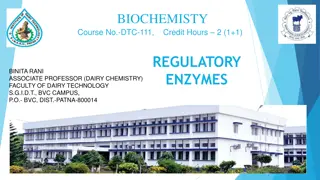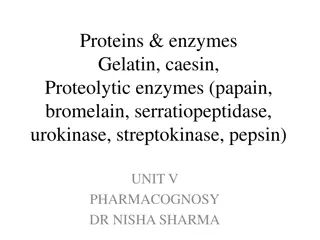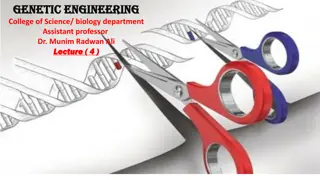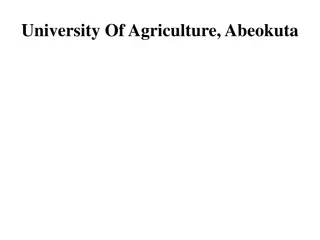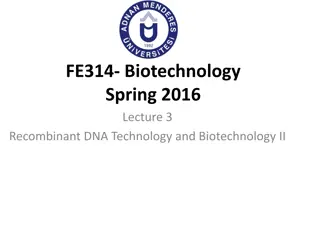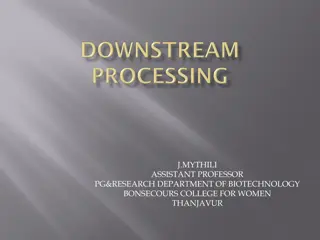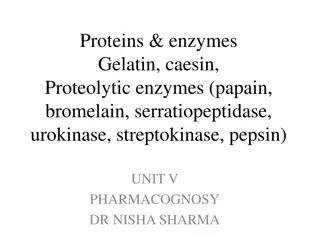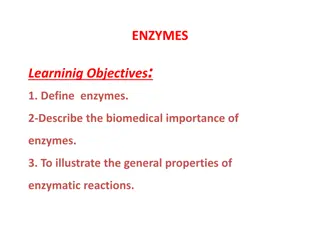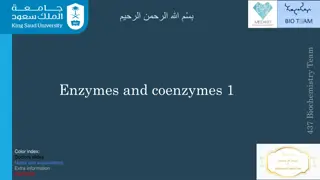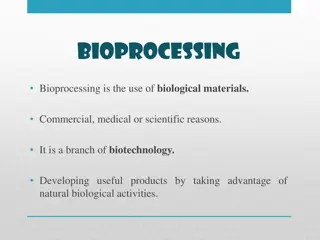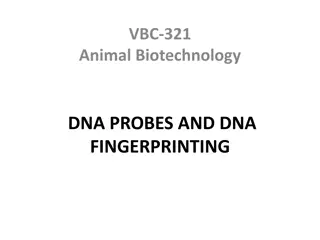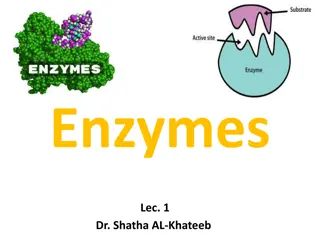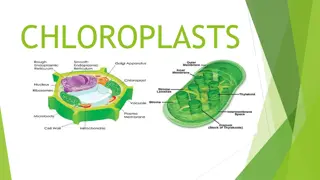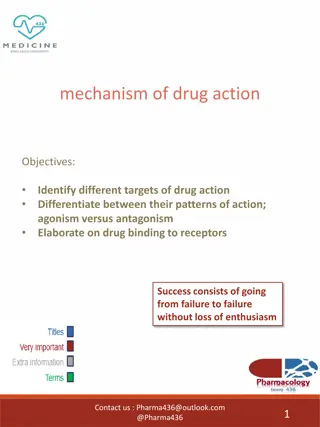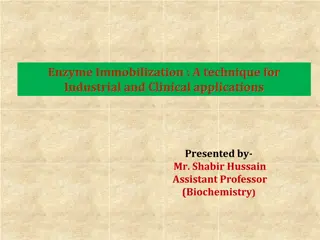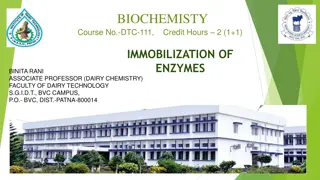Overview of Key Enzymes in Modern Biotechnology
This content provides insights into important enzymes used in modern biotechnology, focusing on DNA ligases and polymerases. It delves into the structures, mechanisms, and characteristics of these enzymes, such as Taq polymerase and bacteriophage T4 DNA ligase. Through detailed descriptions and images, the roles and functions of these enzymes in genetic engineering and molecular biology are explored.
Download Presentation

Please find below an Image/Link to download the presentation.
The content on the website is provided AS IS for your information and personal use only. It may not be sold, licensed, or shared on other websites without obtaining consent from the author. Download presentation by click this link. If you encounter any issues during the download, it is possible that the publisher has removed the file from their server.
E N D
Presentation Transcript
1.1 Introduccin a la Biotecnologa Moderna 1.1.1 Revisi n de conceptos de biolog a Molecular. 1.1.1.1 Enzimas empleadas en la ingenier a Gen tica. 1.1.1.1.1 Enzimas de Restricci n. 1.1.1.1.2 DNA Ligasas. 1.1.1.1.3 Taq Polimerasa. 1.1.1.1.4 Reverse Transcriptasa.
1.1.1.1.2 DNA Ligases DNA ligases close nicks in the phosphodiester backbone of DNA. Two of the most important biologically roles of DNA ligases are: 1. 2. Joining of Okazaki fragments during replication. Completing short-patch DNA synthesis occurring in DNA repair process. There are two classes of DNA ligases: 1. 2. The first uses NAD+ as a cofactor and only found in bacteria. The second uses ATP as a cofactor and found in eukaryotes, viruses and bacteriophages. The smallest known ATP-dependent DNA ligase is the one from the bacteriophage T7 (molecular mass 41 kDa). Eukaryotic DNA ligases may be much larger (human DNA ligase I is > 100 kDa) but they all appear to share some common sequences and probably structural motifs.
DNA Ligase Mechanism The reaction occurs in three stages in all DNA ligases: 1. Formation of a covalent enzyme-AMP intermediate linked to a lysine side- chain in the enzyme. 2. Transfer of the AMP nucleotide to the 5 -phosphate of the nicked DNA strand. 3. Attack on the AMP-DNA bond by the 3 -OH of the nicked DNA sealing the phosphate backbone and resealing AMP.
Bacteriophage T4 DNA ligase Characteristics Molecular mass: Is a single polypeptide with a M.W of 68,000 Dalton. pH: The maximal activity pH range is 7.5-8.0. The enzyme exhibits 40% of its activity at pH 6.9 and 65% at pH 8.3. Ions: The presence of Mg++ ion is required and the optimal concentration is 10mM. Sulfhydryl reagents (DTT, well. Concentrations of NaCl that exceeds 200mM are inhibited. 2-mercapteothanol) are required as Temperature: The optimal incubation temperature for T4 DNA ligase is 16 C. When very high efficiency ligation is desired (e.g. making libraries) this temperature is highly recommended. However, ligase is active at a broad range of temperatures. For routine purposes such as subcloning, convenience often dictates incubating time and temperature-ligations performed at 4C overnight or at room temperature for 30 minutes to a couple of hours usually work well. Others: For intermolecular ligation, especially when the substrate DNAs consist of large DNA molecules PEG (concentrations of 1 % - 10%) appears to stimulate the enzymatic activity .
DNA Polymerases 1. Taq polymerase Taq polymerase is a thermostable DNA pol isolated from Thermus aquaticus), a hyperthermophile bacteria that grows in hot-spring waters. Taq polymerase can catalyze DNA elongation at high temperatures (>90 C).
Taq polymerase (Thermus aquaticus) Taq polymerase Ribbon structure Taq polymerase bound to DNA
Taq polymerase (Thermus aquaticus) Taq polymerase activity animation
DNA Polymerases 2. Reverse Transcriptase
Reverse Transcriptase STRUCTURE The enzyme (red alpha helix and blue beta sheets) bound to DNA (shown in green)
Reverse Transcriptase Characteristics: Reverse transcriptase is a common name for an enzyme that functions as a RNA- dependent DNA polymerase. They are encoded by retroviruses, where they copy the viral RNA genome into DNA prior to its integration into host cells. Reverse transcriptases have two activities: DNA polymerase activity: In the retroviral life cycle, reverse transcriptase copies only RNA, but, as used in the laboratory, it will transcribe both single-stranded RNA and single-stranded DNA templates with essentially equivalent efficiency. In both cases, an RNA or DNA primer is required to initiate synthesis. RNase H activity: RNase H is a ribonuclease that degrades the RNA from RNA-DNA hybrids, such as are formed during reverse transcription of an RNA template. This enzyme functions as both an endonuclease and exonuclease in hydrolyzing its target. All retroviruses have a reverse transcriptase, but the enzymes that are available commercially are derived from one of two retroviruses, either by purification from the virus or expression in E. coli: Moloney murine leukemia virus: MMLV, it is a single polypeptide. Avian myeloblastosis virus: AMV, composed of two peptide chains.
Reverse transcriptase is used to copy RNA into DNA. This task is an integral part in cloning complementary DNAs (cDNAs), which are double strand DNA copies of mature messenger RNAs. The technique is usually initiated by mixing short (12-18 base) polymers of thymidine (oligo dT) with messenger RNA such that they anneal to the RNA's polyadenylate tail. Reverse transcriptase is then added and uses the oligo dT as a primer to synthesize so- called first-strand cDNA.
Another common use for reverse transcriptase is to generate DNA copies of RNAs prior to amplifying that DNA by polymerase chain reaction (PCR). Reverse transcription PCR, usually called simply RTPCR, is a stupefying useful tool for such things as cloning cDNAs, diagnosing microbial diseases rapidly and a myriad of other applications. In most cases, standard preparations of reverse transcriptase are used for RTPCR, but mutated forms with relatively high thermal stability have been developed to facilitate the process



